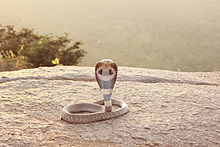
Colubridae is a family of snakes. With 249 genera, it is the largest snake family. The earliest fossil species of the family date back to the Late Eocene epoch, with earlier origins suspected. Colubrid snakes are found on every continent except Antarctica.

Elapidae is a family of snakes characterized by their permanently erect fangs at the front of the mouth. Most elapids are venomous, with the exception of the genus Emydocephalus. Many members of this family exhibit a threat display of rearing upwards while spreading out a neck flap. Elapids are endemic to tropical and subtropical regions around the world, with terrestrial forms in Asia, Australia, Africa, and the Americas and marine forms in the Pacific and Indian Oceans. Members of the family have a wide range of sizes, from the 18 cm (7.1 in) white-lipped snake to the 5.85 m king cobra. Most species have neurotoxic venom that is channeled by their hollow fangs, and some may contain other toxic components in various proportions. The family includes 55 genera with around 360 species and over 170 subspecies.

Hydrophiinae is a subfamily of venomous snakes in the family Elapidae. It contains most sea snakes and many genera of venomous land snakes found in Australasia, such as the taipans (Oxyuranus), tiger snakes (Notechis), brown snakes (Pseudonaja) and death adders (Acanthophis).

Sea snakes, or coral reef snakes, are elapid snakes that inhabit marine environments for most or all of their lives. They belong to two subfamilies, Hydrophiinae and Laticaudinae. Hydrophiinae also includes Australasian terrestrial snakes, whereas Laticaudinae only includes the sea kraits (Laticauda), of which three species are found exclusively in freshwater. If these three freshwater species are excluded, there are 69 species of sea snakes divided among seven genera.
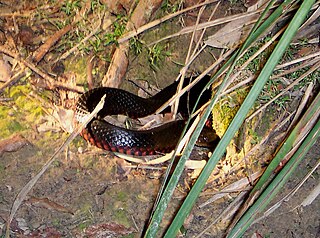
Pseudechis is a genus of venomous snakes in the family Elapidae. It contains the group of elapid species commonly referred to as the black snakes. Species of Pseudechis are found in every Australian state with the exception of Tasmania, and some species are found in Papua New Guinea. They inhabit a variety of habitat types, from arid areas to swampland. All species are dangerous and can inflict a potentially lethal bite. Most snakes in this genus reach about 2 m (6.6 ft) in total length, and vary in colour. Some species are brown, whereas others are black. The most recognisable and widespread species in the genus are the red-bellied black snake and the mulga snake. These snakes feed on lizards, frogs, birds, small mammals, and even other snakes. All species of Pseudechis lay eggs with the exception of the red-bellied black snake P. porphyriacus which is viviparous. The genus Pailsus is a synonym of Pseudechis, and more work is needed to understand species limits among the smaller species of the group.

Sea kraits are a genus of venomous elapid sea snakes, Laticauda. They are semiaquatic, and retain the wide ventral scales typical of terrestrial snakes for moving on land, but also have paddle-shaped tails for swimming. Unlike fully aquatic ovoviviparous sea snakes, sea kraits are oviparous and must come to land to digest prey and lay eggs. They also have independent evolutionary origins into aquatic habitats, with sea kraits diverging earlier from other Australasian elapids. Thus, sea kraits and sea snakes are an example of convergent evolution into aquatic habitats within the Hydrophiinae snakes. Sea kraits are also often confused with land kraits , which are not aquatic.

Micrelaps is a genus of rear-fanged mildly venomous snakes. It is the only genus in the family Micrelapidae. The genus is native to Africa and the Middle East, and there are four species that are recognized as being valid.

The Alethinophidia are an infraorder of snakes that includes all snakes other than blind snakes and thread snakes. Snakes have long been grouped into families within Alethinophidia based on their morphology, especially that of their teeth. More modern phylogenetic hypotheses using genetic data support the recognition of 19 extant families, although the taxonomy of alethinophidian snakes has long been debated, and ultimately the decision whether to assign a particular clade to a particular Linnaean rank is arbitrary.

The Lamprophiidae are a family of snakes found throughout much of Africa, including the Seychelles. There are 89 species as of July 2022.
Hydrophis zweifeli is a species of snakes found from New Guinea to Australia. In the past they were thought to be Hydrophis schistosus, but after DNA testing are now provisionally identified as Hydrophis zweifeli. DNA test have shown they are not related to Hydrophis schistosus.

Colubroidea is a superfamily of snakes in the clade Colubroides that includes Colubridae, with some studies splitting Colubridae into multiple families that make up Colubroidea. Historically, Colubroidea also included other caenophidian snakes such as cobras and vipers, as these snakes form a clade. However these groups are now divided into several distinct, but related, families. Zaher et al. (2009) proposed to redefine Colubroidea for colubrids and related families, while designating Colubroides as the group containing vipers and cobras as well as colubroids. The ReptileDatabase considers Colubroidea to be composed of Colubridae and the members of its sister group, Elapoidea, and does not recognize the division of Colubridae into multiple families.
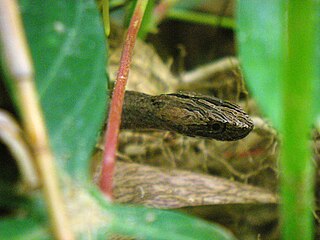
Psammodynastes is a genus of elapoid snakes, containing two species native to tropical and subtropical Asia. It is the only member of the family Psammodynastiidae. They are also known as mock vipers due to their superficial resemblance to true vipers. Their Batesian mimicry of vipers extends to them having a fake venom fang at the front of the mouth revealed during threat displays, although they are actually rear-fanged snakes with weak venom meant for small animals.
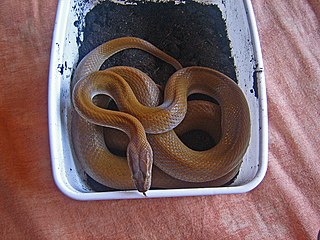
Lamprophiinae is a subfamily of lamprophiid snakes, a large group of mostly African snakes, most of which were formerly classified as colubrids but which we now know are actually more closely related to elapids.
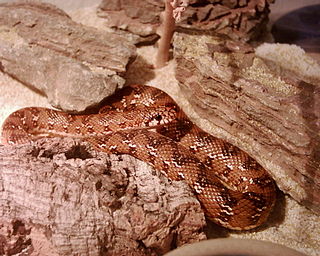
Pseudaspididae is a small family of elapoid snakes, containing only two species from sub-Saharan Africa. They were formerly placed as a subfamily of the Lamprophiidae, but have been more recently identified as a distinct family. However, some authors continue to place them as a subfamily of the Lamprophiidae.

The speckled brown snake or spotted brown snake is a species of venomous elapid snake native to northeastern Australia.

Cyclocoridae is a family of elapoid snakes endemic to the Philippines.

Diploglossa is a clade of neoanguimorphs represented by the families Xenosauridae, Diploglossidae, Anniellidae and Anguidae, the latter three placed in the superfamily Anguioidea. In the past the Chinese crocodile lizard was classified as a xenosaurid; current molecular work has shown evidence the species related to varanoids in the clade Paleoanguimorpha.

Pygopodoidea is a gecko superfamily and the only taxon in the gekkotan subclade Pygopodomorpha. The clade includes three Australasian families: Diplodactylidae, Carphodactylidae, and Pygopodidae. Traditional gekkotan systematics had considered Diplodactylidae and Carphodactylidae as subfamilies of the family Gekkonidae, but recent molecular work have placed Pygopodidae within Gekkonidae making it paraphyletic. These analyses have shown support of Pygopodidae and Carphodactylidae being sister taxa, with Diplodactylidae occupying a basal position in Pygopodoidea.

The Colubroides are a clade in the suborder Serpentes (snakes). It contains over 85% of all the extant species of snakes. The largest family is Colubridae, but it also includes at least six other families, at least four of which were once classified as "Colubridae" before molecular phylogenetics helped in understanding their relationships. It has been found to be monophyletic.

Afrophidia is a clade of alethinophidian snakes comprising the groups Henophidia and Caenophidia, essentially making up the snakes people commonly associate with. The name refers to the deep split between Afrophidia and their sister taxon, Amerophidia, which originated in South American origin, and the afrophidians was recently hypothesized to represent a vicariant event of the breakup of Gondwanan South America and Africa.
